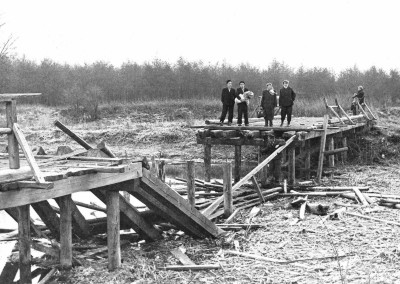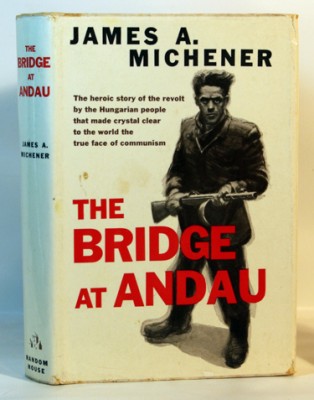|
 On October 23rd, 1956 a national uprising broke out in Hungary. This uprising
was put down by the Soviet troops on November 5th. Over 200,000 Hungarians fled
the country. The "BRIDGE at ANDAU" at that time was indeed the last
possible way into freedom for many.
On October 23rd, 1956 a national uprising broke out in Hungary. This uprising
was put down by the Soviet troops on November 5th. Over 200,000 Hungarians fled
the country. The "BRIDGE at ANDAU" at that time was indeed the last
possible way into freedom for many.
The late American best-selling author James A. Michener had then been
"reporter on the spot." Thereafter, he wrote a book about the dramatic
events, entitled "The BRIDGE at ANDAU". This was, Michener writes,
possibly the least important bridge in Europe. But the twist of fate would have
it become one of the most important bridges in the world for a couple of weeks.
The Andau chronicle tells you about these events:
 On Sunday, November 4th, the roar of tank engines and the rattling of the
chains of armored vehicles approaching the national border was in the air. The
people held their breath, wondering what would happen. Our firefighters went to
the border and marked it with red-white-red flags. ... In the next few days the
first refugees arrived. From day to day, the flow of refugees swelled. Thousands
came from all over Hungary via the Einser channel to Andau, into the freedom of
the West.
On Sunday, November 4th, the roar of tank engines and the rattling of the
chains of armored vehicles approaching the national border was in the air. The
people held their breath, wondering what would happen. Our firefighters went to
the border and marked it with red-white-red flags. ... In the next few days the
first refugees arrived. From day to day, the flow of refugees swelled. Thousands
came from all over Hungary via the Einser channel to Andau, into the freedom of
the West.
This small, insignificant and yet world-famous ANDAU BRIDGE had been blown up a
little bit later. Shortly before Christmas 1956, the future U.S. President
Richard NIXON came as the then Commissioner for Refugees to Andau to get a
picture of this refugee disaster. The population of Andau had been in continuous
use for the refugees.
Here again, the local chronicle:
The municipality and the people of Andau accomplished great humanitarian work in
those days and weeks, which today would be impossible to imagine. The schools,
the kindergarten, the cinema and all public spaces have been provided for the
accommodation of refugees. Today the "BRIDGE at ANDAU" stands again.
It is not only a monument that commemorates the ill-fated times of a divided
Europe, but also a symbol of helpfulness, tolerance and
togetherness across all political boundaries.
 James A. Michener
James A. Michener
"If I ever had to flee, so I hope that it can be to Austria"
Text excerpts from James A. Michener's book "The bridge at Andau"
At Andau there was a bridge. Could someone reach it, he found the way into
freedom.
Only an insignificant bridge, neither wide enough for a car nor strong enough
for a motorcycle. It's rickety .....
Those generations who had once built this bridge could not, of course, know the
role this bridge of simple planks and beams will play one day. .......They came
out of the reeds of the marsh land, from the mud and the dirt, right across the
swamps and via the Einser channel, across the bridge with the rickety beams.
Yes, that's the way they came. Then we heard a dull bang, but nothing was to be
seen. A refugee, who had kept hidden until then, took his opportunity.
Breathless he came running towards us: "They have blown up the
bridge!"
On November 21, 1956, the bridge was blasted by Soviet troops.
|